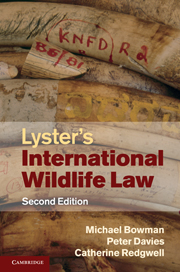Book contents
- Frontmatter
- Contents
- Foreword
- Preface
- List of abbreviations
- PART I Foundations of international wildlife law
- 1 The historical evolution of international wildlife law
- 2 Wildlife and the international legal system
- 3 The philosophical foundations of international wildlife law
- 4 Implementation and enforcement of international wildlife law
- PART II Species regulation
- PART III Regional wildlife regulation
- PART IV Global wildlife regulation
- PART V Biological diversity: a new perspective on wildlife regulation
- PART VI Cross-sectoral issues in wildlife regulation
- PART VII Conclusion
- Index
- References
1 - The historical evolution of international wildlife law
Published online by Cambridge University Press: 05 July 2011
- Frontmatter
- Contents
- Foreword
- Preface
- List of abbreviations
- PART I Foundations of international wildlife law
- 1 The historical evolution of international wildlife law
- 2 Wildlife and the international legal system
- 3 The philosophical foundations of international wildlife law
- 4 Implementation and enforcement of international wildlife law
- PART II Species regulation
- PART III Regional wildlife regulation
- PART IV Global wildlife regulation
- PART V Biological diversity: a new perspective on wildlife regulation
- PART VI Cross-sectoral issues in wildlife regulation
- PART VII Conclusion
- Index
- References
Summary
Introduction
It is difficult to obtain a clear understanding of any legal topic without some sense of the chronology of key developments and the wider historical context out of which they emerged. Areas of legal regulation tend to evolve not in a meticulously planned, orderly fashion, but as an unstructured series of responses to perceived problems, and against the backdrop of the social and political realities of the day. Early attempts to regulate whaling and sealing, for example, must be viewed in light of the considerable economic importance such industries once held, which may be difficult to credit from a purely contemporary perspective. More generally, the political emphasis placed on conservation policy and legal regulation has fluctuated significantly over time, reflecting the prevailing preoccupations of the international community during successive eras. This chapter presents a broad overview of the evolution of international wildlife law against the background of such considerations.
Early developments
The enactment of national legislation to protect wildlife and the environment generally can be traced back to antiquity, with forestry conservation laws adopted in Babylon in 1900 BC and a law for the establishment of nature reserves promulgated in Egypt in 1370 BC. The use of international legal instruments for this purpose is a much more recent phenomenon, however, dating essentially from the final quarter of the nineteenth century.
- Type
- Chapter
- Information
- Lyster's International Wildlife Law , pp. 3 - 23Publisher: Cambridge University PressPrint publication year: 2010



